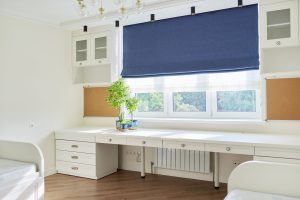Imagine you’re preparing for guests and notice your wooden blinds look dusty and grimy. You might wonder if a microfiber cloth is enough or if you need a more thorough approach. Dusting regularly with a vacuum’s brush attachment can help, but what about those stubborn stains? You could mix mild dish soap with warm water, but is that the best solution for deeper cleaning? There’s also the option of testing a vinegar and water mixture. To guarantee your blinds look their best, it’s vital to know the right tools and techniques. Curious about the most effective methods?
Key Takeaways
– Dust regularly with a microfiber cloth or vacuum with a brush attachment to prevent buildup.
– For deep cleaning, lay blinds flat and use a mild dish soap solution with a soft sponge.
– Use a toothbrush for cleaning tight spots and hard-to-reach areas.
– Test vinegar and water solution on a small area before using it on the entire blind.
– Apply wood conditioner or polish every few months to maintain the blinds’ finish and durability.
Essential Tools and Materials
To efficiently clean your wooden blinds, you’ll need a few essential tools and materials that guarantee the job is done thoroughly. First, gather a microfiber cloth or duster. Microfiber is excellent because it traps dust without scratching delicate surfaces.
You’ll also need a vacuum cleaner with a brush attachment, which helps remove any loose dirt or debris from the blinds.
Next, have a bucket of warm water mixed with a small amount of mild dish soap ready. The soap will help break down any grime without damaging the wood’s finish. Don’t forget a soft sponge or cloth for wiping down the blinds gently.
A toothbrush can be particularly useful for reaching into those tight spots and corners where dirt tends to accumulate.
Additionally, keep a dry, clean cloth on hand. After washing, you’ll need to dry the blinds thoroughly to prevent water spots or warping.
For added shine and protection, consider using a wood polish or conditioner specifically designed for wooden surfaces. This won’t only make your blinds look great but also extend their lifespan.
With these tools and materials, you’re fully equipped to give your wooden blinds a thorough and effective clean.
Quick Dusting Techniques
Start by closing the blinds fully to one side, allowing you to effectively dust each slat with a microfiber cloth or duster. This initial step guarantees that you capture dust without scattering it around. Begin at the top slat and work your way down. Use gentle, consistent strokes to avoid damaging the wood.
For a more effective clean, consider these quick dusting techniques:
- Use a vacuum with a brush attachment: This method helps capture dust without recirculating it into the air. Pass the vacuum gently over each slat, ensuring you cover both the top and bottom surfaces.
- Feather duster: A feather duster can be a quick solution for regular maintenance. Lightly glide it across the closed slats to pick up loose dust. Make sure you shake out the duster outdoors after each use to keep it effective.
- Dry microfiber cloth: This is a great tool for a more thorough dusting. It traps dust effectively and can be used on both sides of each slat. Simply close the blinds in the opposite direction to access the other side.
Removing Stubborn Stains
When tackling stubborn stains on your wooden blinds, you’ll need a gentle yet effective cleaning solution to safeguard the wood’s finish. Begin by mixing a few drops of mild dish soap with warm water in a small bowl. Dip a soft cloth or sponge into the soapy water, then wring it out so it’s damp but not soaking wet. Gently wipe the stained area, making sure not to saturate the wood, as excess moisture can damage it.
If the stain persists, you can try a mixture of equal parts white vinegar and water. Test this solution on a small, inconspicuous area first to confirm it doesn’t affect the finish. Apply the vinegar solution with a soft cloth and gently rub the stained area in the direction of the wood grain.
For particularly stubborn stains, consider using a specialized wood cleaner. Apply the cleaner according to the manufacturer’s instructions, typically with a soft cloth.
Always follow up by wiping the area with a dry cloth to remove any residual moisture and prevent water damage.
Remember to be gentle throughout the process to maintain the integrity and appearance of your wooden blinds.
Deep Cleaning Methods
After addressing stubborn stains, it’s important to periodically perform a deep cleaning to keep your wooden blinds looking their best. Deep cleaning not only removes accumulated dust and grime but also helps maintain the wood’s natural finish.
First, take the blinds down from the window to give them a thorough cleaning. Lay them flat on a clean surface, preferably outside or in a spacious area. Use a soft brush attachment on your vacuum cleaner to remove loose dirt and dust. This step guarantees you don’t scratch the wood during the washing process.
Next, prepare a cleaning solution. Mix a small amount of mild dish soap with warm water. Dip a soft cloth into the soapy water, wring it out well, and gently wipe each slat. Avoid soaking the wood, as excess moisture can cause warping.
Finally, dry the blinds immediately with a clean, dry cloth. This step prevents water damage and ensures that no soap residue is left behind.
Here are some tips to make the process easier:
- Use a microfiber cloth: It’s gentle on the wood and effective in picking up dust.
- Work in sections: This helps you manage the cleaning process efficiently.
- Rotate the slats: Make sure you clean both sides thoroughly.
Maintenance Tips
To maintain your wooden blinds in top shape, regularly dust them with a microfiber cloth to prevent dirt buildup and maintain their natural shine. Aim to dust them at least once a week. Start from the top slat and work your way down, ensuring you cover both sides of each slat. This routine will minimize the need for frequent deep cleaning.
Don’t overlook the importance of spot cleaning. If you notice a stain or spot, use a damp cloth with a mild detergent. Wipe gently and dry immediately with a clean, dry cloth to avoid water damage. Never soak the blinds, as excess moisture can warp and damage the wood.
Remember to use a vacuum with a brush attachment for a more thorough clean. Set the vacuum to a low setting and gently run it over the slats. This method is particularly effective for removing dust from hard-to-reach places.
Lastly, consider applying a wood conditioner or polish every few months. This will nourish the wood and enhance its longevity. Follow the product instructions carefully, and always test on a small area first to ensure it doesn’t discolor the wood. Keeping these maintenance tips in mind will help your wooden blinds stay beautiful and functional for years to come.
Frequently Asked Questions
Are There Any Eco-Friendly Cleaning Solutions for Wooden Blinds?
Yes, you can use a mixture of equal parts water and white vinegar. It’s effective and eco-friendly. Dampen a cloth with the solution, wipe each slat, and dry immediately to prevent water damage.
Can I Use a Vacuum Cleaner to Clean Wooden Blinds?
Did you know that 80% of dust particles can be effectively removed with a vacuum? You can use a vacuum with a brush attachment to clean wooden blinds, ensuring you don’t scratch or damage the surface.
How Often Should Wooden Blinds Be Cleaned?
You should clean your wooden blinds every two weeks to prevent dust buildup. Regular maintenance guarantees longevity and keeps them looking fresh. Use a microfiber cloth or vacuum with a brush attachment for best results.
Is It Safe to Clean Wooden Blinds With Water?
Think of your wooden blinds as delicate parchment. It’s safe to use a damp cloth, but avoid soaking them. Excess water can warp the wood, so always wring out the cloth well before cleaning.
What Should I Do if My Wooden Blinds Start to Warp?
If your wooden blinds start to warp, you should stop using water on them immediately. Instead, use a dry cloth for dusting and a wood conditioner to restore moisture. Consider replacing severely warped slats for best results.
Conclusion
Think of your wooden blinds as a loyal old ship sailing through dusty seas. Regularly dust them like swabbing the deck to keep them shipshape.
For stubborn barnacles, a bit of soap and warm water will do wonders. Deep cleaning? It’s like docking for a thorough overhaul; lay them flat and scrub both sides.
Finish by drying them to prevent water damage. Treat them well, and they’ll serve you faithfully for years to come.
















